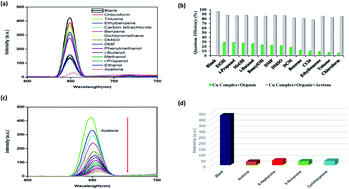A fluorescent Cu(ii) complex as a dual functional sensor for selective and sensitive detection of acetone and Cd(ii) pollutants†
Abstract
In this study, Cu2+ perchlorate complexes of 3,5-dimetylpyrazole(dmpy), namely [Cu(dmpy)3(H2O)2](H2O)(ClO4)2 (1), were prepared and characterized by X-ray diffraction (XRD), thermogravimetric analysis (TGA), infrared (IR) spectroscopy, elemental analysis, mass spectrometry, and ultraviolet visible (UV-Vis) spectroscopy. It was determined that Cu2+ coordinated to the nitrogen atoms of three dmpy molecules as well as to the oxygen atoms of two H2O molecules in a square pyramidal geometry. To balance the charge, two uncoordinated perchlorate anions and one H2O molecule were also present in the lattice. The resulting Cu2+ complex was involved in extensive hydrogen bonding, which stabilized the structure. The fluorescence properties of complex 1 were studied in acetonitrile at room temperature upon the addition of different organic solvents. It was confirmed that the complex exhibited remarkable acetone selectivity via a fluorescence quenching mechanism. At low concentrations, the fluorescence intensities were nearly completely quenched via a turn-off mode. Moreover, complex 1 displayed exceptional selectivity, fast detection time, and high sensitivity for Cd2+ in aqueous solutions via a fluorescence enhancement mechanism (turn-on mode). Hence, the prepared complex showed potential for application in Cd2+ detection. Notably, in an aqueous solution, complex 1 exhibited highly selective fluorescence enhancement effects (turn-on mode) with respect to Cd2+ and was not affected by the interference of other metal ions.



 Please wait while we load your content...
Please wait while we load your content...